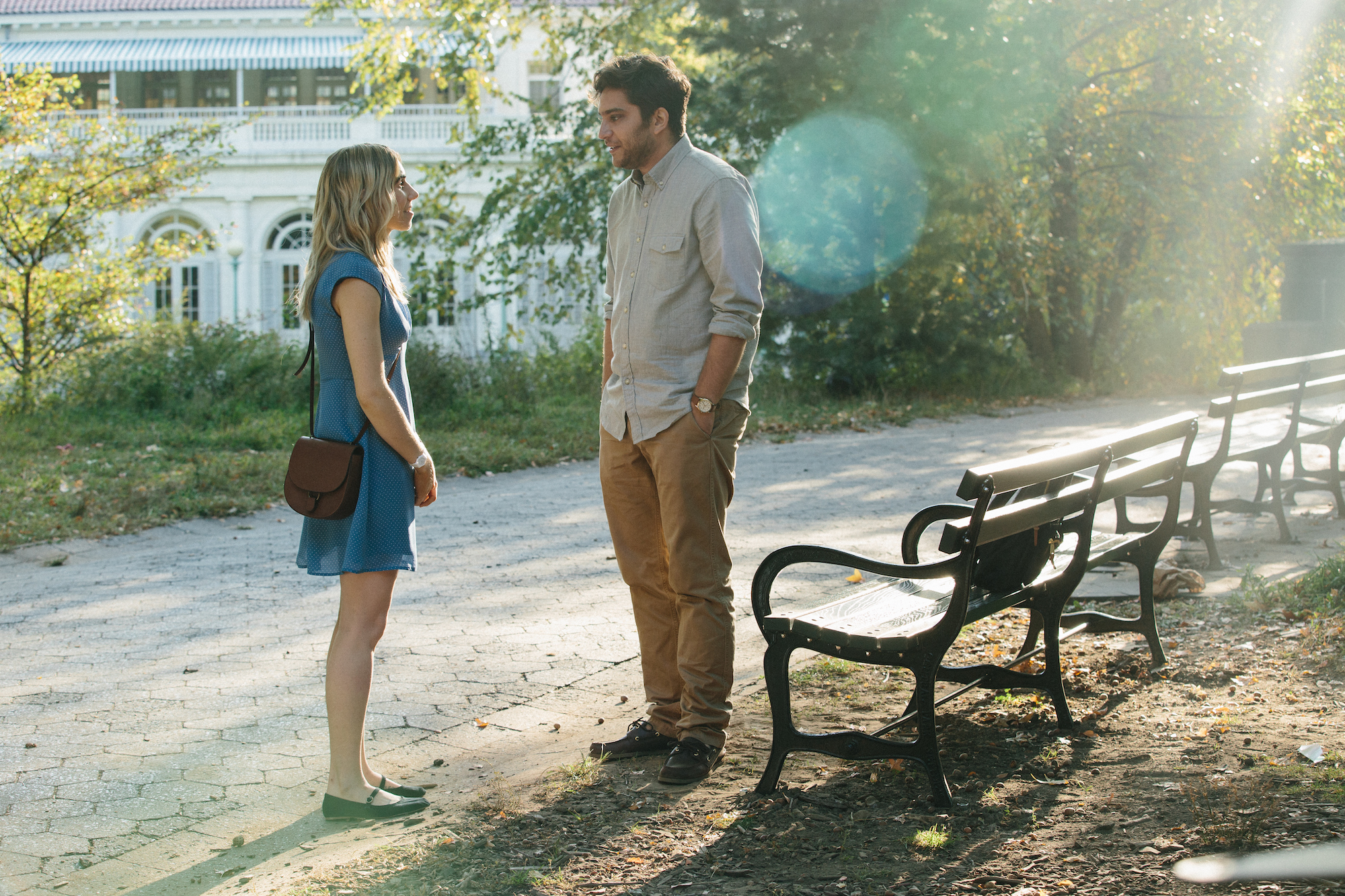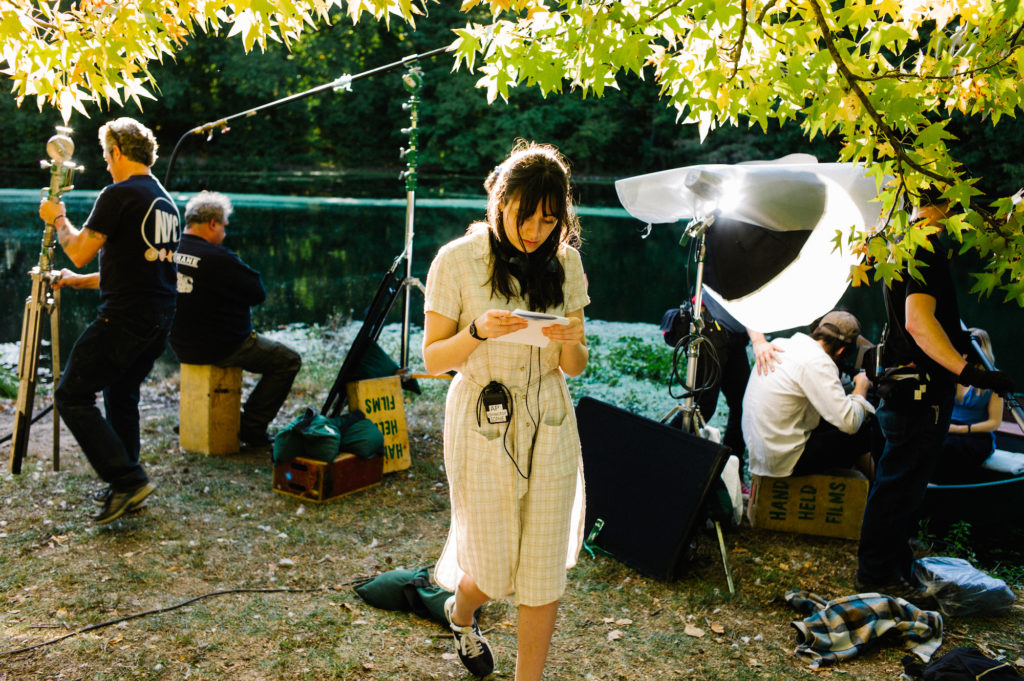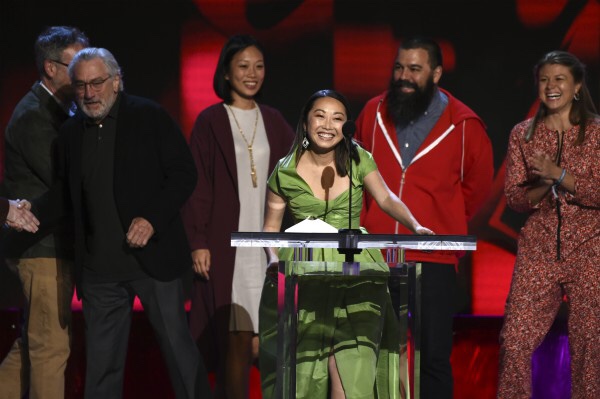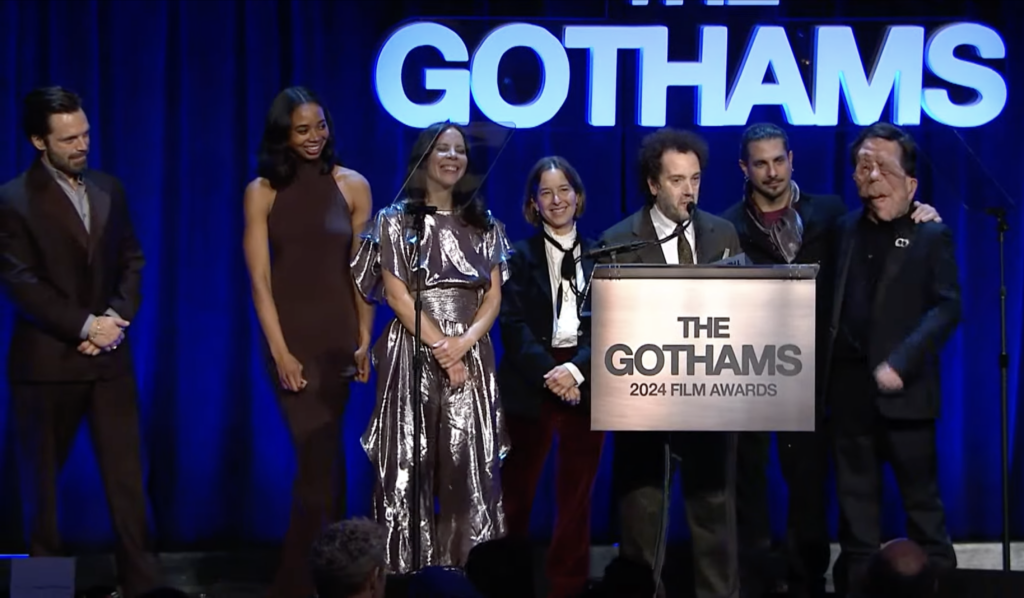The new indie romantic comedy THE BOY DOWNSTAIRS finds aspiring novelist Diana (Zosia Mamet) recently returned to New York from a three-year stint abroad. After moving into her new Brooklyn brownstone apartment, Diana’s homecoming gets complicated when she finds an unexpected neighbor in her building: Her ex-boyfriend Ben (Matthew Shear). The film, which premiered at the 2017 Tribeca Film Festival, is written and directed by SOPHIE BROOKS.
Rom-com devotee Brooks, an NYU Tisch School graduate, previously wrote and directed the short film Maple Leaves. She conceived of the story for The Boy Downstairs – her feature debut – while recovering simultaneously from a car accident and appendicitis. (And if you can survive a double-emergency like that, making an indie feature should be a breeze, right?)
Now audiences can see how Brooks’s hard work has paid off. FilmRise will release The Boy Downstairs in New York on February 16, and Los Angeles on February 23. We spoke with writer/director Sophie Brooks to learn more about her movie, her career, and working in the romantic comedy genre.
——
COLIN McCORMACK: With most movies – but especially with romantic comedies – the strength really lies in the chemistry between the leads. So I wanted to start by talking about how you ended up casting Zosia Mamet and Matthew Shear.
SOPHIE BROOKS: Zosia was the first actor that we sent the script to. We sent the script to her agent in a pretty standard way, and they sent it to her and she read it and liked it. Then I met with her a few weeks later and we just immediately hit it off and connected on our understanding of the character and the movie and really bonded over our general neuroses and anxieties about being a human being, which was fun [laughs]. And then basically that day, we committed to each other. That’s how she came to be.
With Matt, my casting director Kerry Barden had set me up on a meeting with his agent. She pitched him to me and I saw Mistress America, which he was in, and loved him in it. Then I met with him in New York, and he is so charming and lovely and such a kind human being. We also hit it off right away and I thought he had such sincerity and depth behind his eyes that I really wanted for the main character. I wanted this humility and sincerity that Matt has. So that’s how I cast them both, and then I introduced them to each other in kind of a funny way. The same way they meet in the movie, which is we went to Central Park and went on a boat ride, the three of us. We kind of had a first date together, which was fun.
CM: So you had already decided on them before putting them together and seeing what their chemistry was like?
SB: I did, yeah. And I didn’t audition either of them; I just met with them and had a good sense of each of them. And I had obviously seen Zosia in Girls and kind of watched every single thing she had been in, and the same with Matt. I just felt like they would work together. And I think that they did.
CM: You guys did some improv, correct?
SB: We did, yeah.
CM: Is that something you expected to do going in or was it just the way your relationship with Matt and Zosia worked out, that it ended up being a good fit to work together and collaborate through improvisation?
SB: It was definitely not the thing I had planned. But it kind of started in the rehearsal process. We were able to do some rehearsals, which was great. In the rehearsals we did some improv. Sometimes scenes that weren’t even in the movie – I would give them a scenario and then they would improv what would happen in that scene. And then sometimes we were doing improv on scenes that were written – I would sometimes take those improvs and work them into the script. Then also when we were on set, what we would do is at the top of the day or the top of each scene, read through the script, go through the blocking, and if anything didn’t feel quite right I would let them start [improvising] things to adjust. Then once we got a rhythm that felt right, we would commit to that and do coverage on whatever that improv had birthed, basically. And then every now and then, words here and there would be [improvised] off the cuff, but generally, we would stick to what we decided at the beginning of shooting the scene.
CM: Speaking of the ability to adjust things, the film features a lot of flashbacks to the ups and downs of their relationship. Was the placement of each flashback consistent with how it was written, or were you able to restructure, make new discoveries, and adjust in the edit?
SB: That’s a good question. You know, I think everything was where it was written except for one flashback, and I can’t remember which one it is now. But yeah, everything is as written. Gosh, which [flashback] is it? I can’t remember, but it was something in the first act or the first half of the movie, that we ended up moving by a few scenes. But pretty much everything else was where it was written.
CM: How did having flashback scenes add difficulty to the shooting schedule?
SB: It didn’t add that much difficulty, other than the fact that Zosia had longer hair in the flashbacks so she was in hair and makeup longer. She had to have extensions [put in] for when we were doing flashbacks. So that added time at the beginning and end of the day for her and the makeup team. Other than that, it was only a three-year difference [between timelines], so it wasn’t that much of a struggle. It was more of a struggle trying to navigate the seasonal changes, because we were shooting in the fall in New York and we had to have summer and winter and spring and fall in 21 days.
CM: So what are some of your tricks to achieve a full year’s worth of New York in 21 days?
SB: It was tricky. And we were a pretty small budget so we didn’t have the luxury of a huge studio movie to spend tons of money on that stuff. So we definitely had to use tighter shots at points. There were leaves everywhere, so we had a lot of leaf blowing going on and sweeping up leaves when it wasn’t supposed to be fall. For winter we had fake snow, which does the trick. For some of the summer stuff, if was really freezing and Zosia and Matt just had to do a good job of pretending that they weren’t freezing and putting heating pads under their costumes. The Halloween scene, in particular, was really a freezing, freezing day on a rooftop in New York in the middle of the night. And Zosia was also sick. She was such a trooper, as were the other actors, and we kept giving them hot things to keep them warm. It definitely was challenging, physically and logistically speaking.
CM: Yeah, anyone who’s been on the east coast on Halloween knows it can suddenly be winter that one day of the year when everyone wants to be outside.
SB: Yeah, it was freezing. We incorporated that into the scene, where [Zosia] says, “Why are we on a rooftop?” We couldn’t ignore the fact that it was so cold.
CM: And I heard that your original location for the apartment had dropped a few days before shooting?
SB: It dropped the week before shooting. I think five days before. It was a bummer.
CM: You ended up with such a great building. Were you able to use that apartment for both interiors and exteriors?
SB: We did, yeah. It was really great that we found it because it was already a converted townhouse, but there were different apartments in the building. So we used it for everything set at the house.
CM: When a near emergency like losing your location happens, do you just immediately go into problem-fixing mode or was there a moment of sheer panic for a little bit?
SB: I think we just went into problem-solving mode. We had great location managers and the location we ended up getting was actually relatively close to where our offices were, so once it fell out I think we found the place within a day. I think if it had been the day before, I would have panicked. But everything moves so quickly on a movie set that for some reason, the five days – it was still super stressful – but also like, Oh we’re gonna work it out. Because we have to.

CM: Were there other stressful moments that ended up being a blessing in disguise?
SB: We had a pretty rough day when we were shooting the park scene in Prospect Park. There used to be an extended part of the scene that involved rain, and we didn’t have enough rain machines and we had a light that caught on fire and a lot of logistical things went really wrong. That was probably the hardest day I had on set. Because when things that are completely out of your control go wrong, it’s really stressful and you’re also like, But how could I have prepared for this? How could I have prepared for a light catching on fire? So that day kind of made me rewrite the second flashback because I wanted to know that if that scene wasn’t salvageable – which it ended up working great in the movie and I’m so happy we had it – but I wanted to have another scene that could work as the first flashback. So I ended up rewriting the scene where they’re at the art party in the flashback, inside the [art installation] room within the room, and I was really happy with how that turned out. It was a really happy outcome for an unfortunate situation.
CM: When having to solve those types of problems, it helps when you have a close relationship with your producer. And your producer is your brother David.
SB: Yes.
CM: I assume you guys know each other well enough to figure things out together. When did you start working together on a professional level?
SB: He had edited my short film, so we had worked on three short films together in post. But this is the first time working together in a producer-director dynamic. We’re very close and we had a great experience. It’s obviously very challenging at times working with family, especially when you’re close because there’s kind of no filter. Which could be a good thing sometimes or not.
CM: [Laughs] You know the dig that could really get to them if you need to.
SB: Exactly. And vice-versa. I think it was a very challenging but rewarding experience, and I definitely want to work with him again and he is going to produce my next movie. So even though it’s not all easy, I’m so grateful for him and Dan [Clifton] signing on to produce it, and for the relationship that we have that enabled it to survive.
CM: Growing up, were you the types of kids who made movies in the backyard and stuff?
SB: No, not at all. I didn’t know that I wanted to be a filmmaker until I was a sophomore in college. I originally went to NYU for photography, and then quickly realized I was really bad at photography. [Laughs] I needed to figure out something else. And I had worked on a movie in the costume department over the summer and absolutely loved being on set. So I thought, Ooh, I actually think I want to do something that involves being on set. And even then, I didn’t necessarily know that I wanted to write and direct and I didn’t know if I could do it or had a skill for it. But at NYU [during] your sophomore year, everyone has to make a short film. So I made a short film and it was just the most fun, exciting, and challenging thing I’d ever done. So I thought, Okay, this is what I want to do. And I didn’t look back.
CM: Have you kept in touch with a lot of NYU alums? Did you build a filmmaking community there that has continued post-college?
SB: Definitely. One of my best friends, Auriel Rudnick – who I went to NYU with and also went to high school with – is also a writer, and we met a lot when I was writing The Boy Downstairs. She would show me the pilot she was writing and I would show her The Boy Downstairs and we would exchange notes. And Diana Irvine, who plays Gabby in the movie, also went to NYU and I met her there and she was in my thesis film. And I have a bunch of other really good friends I went to NYU with, and my boyfriend went to NYU. There’s definitely a strong NYU bond.
CM: In terms of resources as you were writing the script, I’d heard you reference Robert McKee’s Story as helpful. Were there other resources that you found yourself returning to, either on the screenwriting side or directing side?
SB: Oh Gosh, I read a ton of books. Robert McKee’s Story, but I also read books about writing a romantic comedy. I read this book that I can’t fully remember the title, but it’s something like Your Screenplay is Terrible, Here’s Why. [Laughs] A ton of books about writing. And I watched a ton of romantic comedy as references. I watch romantic comedies in regular life as well, so I think I had a pretty good sense of them. But I definitely paid more attention when I was writing and was watching them more critically. It was kind of a combination.
CM: Were there any films outside the romantic comedy genre that were particularly influential either to the story or the visual aesthetic?
SB: Beginners was a big influence for me visually. I think it’s a great movie and it’s also just so beautiful to look at. Mike Mills has such an amazing visual style that I really look up to. That was a big reference. I made a pretty extensive reference book of images that my DP [Stefan Weinberger] and I kept on set and would go through and look at when we were composing shots. I can’t remember more movies off the top of my head, but Beginners is definitely one that sticks out.
CM: Is it true you had [You’ve Got Mail screenwriter] Delia Ephron as a mentor?
SB: Um, yeah. I don’t know if she would call it that. [Laughs] But she was really generous with her time and met with me and read my script and gave me notes on it. And I kind of think of it [as a mentorship], but I don’t know if she would describe it that way. I’m so grateful for all the help that she gave. She’s such a talented writer and also has a really great way of being encouraging and also no bullshit, which I really appreciate and respect.
CM: Is there anything in particular that you learned from her that you applied to The Boy Downstairs or plan to bring with you to future projects?
SB: A lot of stuff. The first draft I wrote of The Boy Downstairs that she read, she told me – I don’t remember her exact quotes – but there were a lot of things that I thought were obvious that weren’t on the page. And she made me realize that just because I know the character really well, if I’m not putting it on the page no one else is going to know. So I think the importance of really making it clear who your character is and not just assuming things are coming across was really good advice.
CM: In the film as Diana pursues her writing career, she works at a bridal shop. Have you had any sort of demoralizing day jobs while you were pursuing filmmaking?
SB: I worked at a bridal shop! Yeah, so I did that. It was also regular retail, but it was mainly bridal and we had bridal appointments. I also babysat a couple children. It’s obviously not what I wanted to be doing, but I also have a nostalgia for that time when I was lost and figuring out my life. And I’m still figuring out my life and I’m still lost, but I have a little bit of a better sense of it. I do really think I made an active decision to not get a job at a production company or an agency. Because I knew that I wanted to write and direct, and I knew that I needed a day job that was going to enable me to actually write, and not give me – this sounds weird – too much happiness from my job. Because I didn’t want to settle.
CM: Don’t want to get too comfortable.
SB: Exactly. I wanted something that was going to push me to be like, Okay, you don’t want to be doing this for the rest of your life, so get going.
CM: As a writer, generally how disciplined are you? Do you have a strict writing schedule where you get up at X time or write for this many pages or this many hours, or is more of an organic flowing process?
SB: No, I’m pretty scheduled and organized, I would say. It’s hard to figure out what I’m doing when I’m brainstorming or outlining because it’s hard to know how much work you’ve gotten done because a lot of it is internal. So when I’m in that stage of writing, I’m kind of more loosey-goosey and I’ll dedicate a certain amount of hours and I’ll go for walks and I’ll take a notebook and I’ll write that way. But when I’m actually writing a script, I do five pages a day, five days a week. And I don’t let myself go to sleep until I’ve done that.
CM: How many drafts did you go through of The Boy Downstairs before you had a version you were comfortable moving forward with as something to make?
SB: I actually didn’t do that many of The Boy Downstairs. I think I maybe did around five or six [drafts]. I just finished a new script and I did so many drafts that to me, five or six doesn’t seem like that much. But it’s a good amount, I think. There are some changes when you’re in pre-production and production – like when budget things come up – where you have to cut stuff out that you had planned on shooting. So it was definitely changing up until we finished.
CM: What’s next for you? And for the time being, do you plan on staying in the romantic comedy genre?
SB: I just finished a new script, so I’m really excited about that and I hope to make it— I hope this year, if people want to make it with me. I would say it’s in the same vein as The Boy Downstairs, but it’s more of a family ensemble. But the tone is romantic comedy. Right now I feel at least for my next film, that’s the world I want to stay in. I love romantic comedies and that’s probably what I’m always going to lean towards, but I’m certainly open to other genres. I also have been working on a horror-comedy for fun that I’ve been writing for myself. I’m definitely open to other things, but right now romantic comedy feels like home to me.
__
Thanks to Sophie Brooks for talking with us about THE BOY DOWNSTAIRS. Learn more about the film at the FilmRise website, or on Facebook, Instagram, or Twitter.
This interview has been edited for clarity.
If you’re an independent filmmaker or know of an independent film-related topic we should write about, email blogadmin@sagindie.org for consideration.





